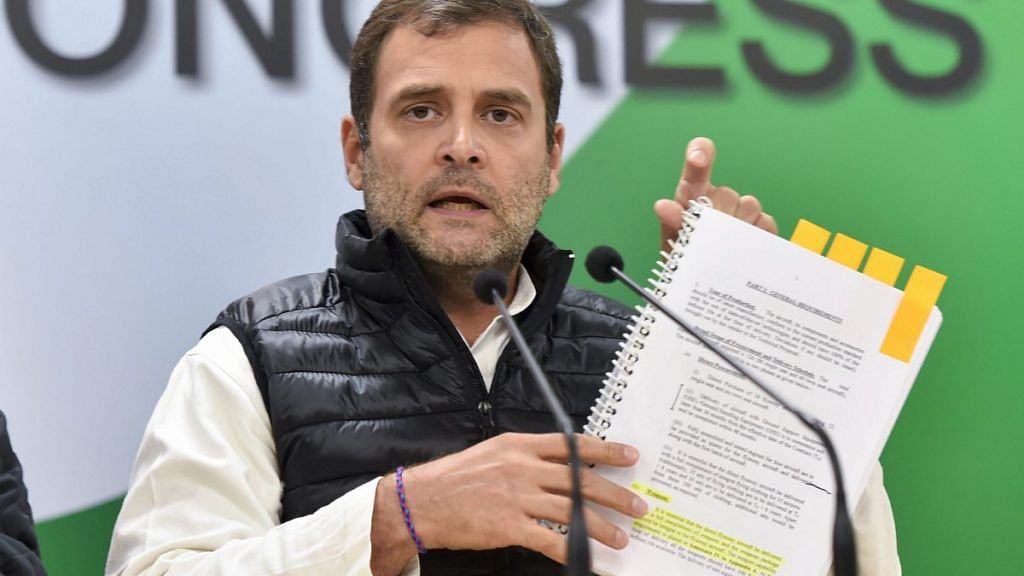For India, it is the season of miscalculation.
In the heated debate on the Rafale deal in Parliament, the Congress, the chief Opposition, and the ruling Bharatiya Janata Party (BJP), have been throwing a lot of big numbers at each other.
To understand the fine print, it is important to decode the staggering numbers and see how the Congress’s UPA and the BJP’s NDA fare on the Rafale deal.
Also read: There’s a humongous scam in the Rafale deal. It is called stupidity
The UPA deal that wasn’t
Congress president Rahul Gandhi keeps pitting the figure Rs 526 crore per aircraft negotiated by the UPA—during Manmohan Singh’s tenure as PM—for a fully weaponised Rafale against the Rs 1,600 crore per aircraft signed by the Modi government for 36 Rafale jets.
So, how did the figure ‘Rs 526 crore’ possibly come about? The MRCA tender of 2007 was budgeted at $10.4 billion, which gave the contenders an indication of what India’s expectations were. The exchange rate for the dollar in 2007 was about Rs 40, pegging the deal at about Rs 42,000 crore, or about Rs 330 crore per fighter.
The Medium Multi Role Combat Aircrafts tender (MRCA tender) had specific requirements from the Indian Air Force, including the provision of AESA radar, radar warning receiver, helmet-mounted display, ability to take off and land at high altitudes in cold conditions, firing beyond visual range missiles and standoff attack capabilities.
The French Senate report of 2013 put the flyaway cost of the single seat Rafale C at €68.8 million. The Defence Services Assistance Agency defines: “Flyaway cost include the cost of procuring the basic unit (airframe, hull, chassis, etc.), a percentage of basic unit for changes allowance, propulsion equipment, electronics, armament, and other installed government-furnished equipment, and nonrecurring production costs.”
Also read: India has a right to know how the CJI-led bench went wrong with Rafale judgment
Given the conversion rate of the Euro was Rs 56 in 2007, the flyaway cost of Rafale comes to about Rs 385 crore, which is quite close to the budgetary estimate of the MRCA tender.
In 2014, the UPA government said there was no money to ink an agreement in that financial year, and as elections were due, it was left to the next government to conclude the deal.
At the time, the Euro stood at about Rs 80, which meant that in rupee terms, the cost of the Rafale had escalated to about Rs 550 crore—considering the known flyaway cost of €68.8 million. This is probably why Rahul Gandhi and the Congress quoted the figure of Rs 526 crore.
Again, here I am merely trying to make sense of the figures being thrown around.
The UPA government was not close to sealing the deal with France as negotiations were stuck on various aspects of costs and guarantees for the work done by Hindustan Aeronautics Limited (HAL). Dassault was in violation of the terms of the MRCA and lost the L1 or lowest bidder status after it escalated costs. The price does not include the design and development cost of the jets which, if added, would take the price to €160 million a jet.
The NDA deal that shortchanged India
The official indication of how much the 126 jets would cost came from then defence minister Manohar Parrikar when he said it was pegged at Rs 90,000 crore ($14.5 billion), or Rs 714 crore per jet.
However, in April 2015, PM Modi announced his decision to buy 36 Rafale jets. At this point, there was no clarity on how much they would cost. Subsequently, negotiations were held and a €7.87-billion deal signed in September 2016, which translated to about Rs 58,000 crore. That is where the figure of Rs 1,600 crore per jet came from.
Although the government has refused to share the details, a breakup of the cost has been reported. It put the price of 36 jets at €3.3 billion: the cost of India-specific enhancements stood at €1.7 billion, spares and other supplies at €1.8 billion, weapons package at €710 million and performance-based logistics at €353 million.
This is where the problem may lie—in terms of the price France has extracted from India. India-specific enhancements stood up to nearly €50 million a jet. All these enhancements—as mentioned earlier—were requirements in the MRCA tender for which all the six contenders, including Dassault, had quoted the base price and budgeted. (In 2007, it was a $10.4-billion deal for 126 jets.)
The MRCA tender included lifecycle costs that would involve the supply of some of the associated spares—currently pegged at €1.8 billion—which again works out at €50 million a jet.
Also read: On Rafale, BJP is not corruption free but investigation free
These two headings provided the French with the opportunity to probably recover some of the development costs, which stood at €25 billion. The benchmark price was set when France announced a deal with Qatar for 24 Dassault jets, priced at €6.3 billion in April 2015. This included missiles like Meteor and Scalp among others that India too has sought to procure.
The cash-rich Qataris could afford it and their requirement was limited. They subsequently bought another 12 jets for €1.1 billion under the ‘options’ clause.
Note that India has not negotiated any options clause.
The Congress is, therefore, wrong in saying it would have got the Rafale jets for Rs 526 crore since France had breached the MRCA terms and was not willing to move from its position.
The Modi government, on its part, erred in announcing a deal whose price it did not know and handed France an opportunity to rip India off.
To put things in perspective, Japan recently announced its decision to buy 100 F-35 fifth generation fighters for $8.8 billion—with AESA radar, helmet-mounted display, jammers, sensors et al.
Yusuf T. Unjhawala is the editor of Defence Forum India and a commentator on defence and strategic affairs. He tweets @YusufDFI
